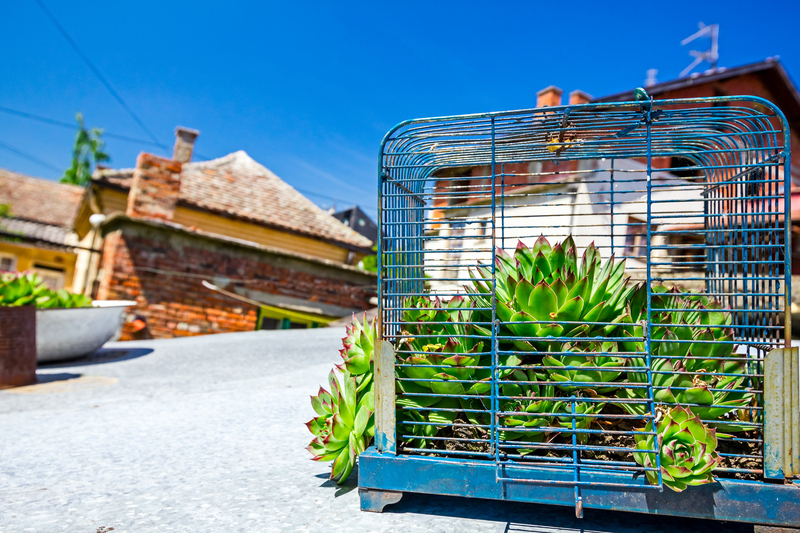Lush Living Walls: The Beauty of Vertical Gardening
Posted on 08/06/2025
Lush Living Walls: The Beauty of Vertical Gardening
Vertical gardening has transformed modern architecture and home decor, inspiring a new realm of sustainable and aesthetic design. Lush living walls--also known as green walls, vertical gardens, or vertical plant walls--combine function with artistry, turning bland facades and interiors into vibrant, oxygen-rich havens. This comprehensive guide delves into the wonders of living walls, exploring their benefits, structure, design styles, maintenance, and sustainable impact. If you are considering embracing the beauty of vertical gardening, this article is your ultimate resource.

What Are Living Walls?
A living wall is a vertical arrangement of plants, supported by a structure that attaches to an interior or exterior wall. These gardens can range from simple, small-scale projects to extensive installations that cover entire buildings. Living walls encapsulate the essence of biophilic design by bringing nature into human spaces, offering both practical and aesthetic advantages.
Types of Vertical Gardening Systems
- Modular Panels: Pre-made panels or blocks that slot into place, each supporting a set of plants and growing media.
- Tray Systems: Horizontal trays affixed to the wall, enabling easy plant arrangement and replacement.
- Pocket Planters: Fabric pockets, often made of felt or recycled materials, offering lightweight options for interior green walls.
- Trellises and Climbing Plants: Simple trellises allow climbing or vining plants to scale vertical surfaces, a favorite for DIY gardeners.
The Multifaceted Advantages of Lush Living Walls
Opting for vertical plant walls adds more than just a burst of natural beauty--it offers a myriad of benefits for people and the environment.
Environmental Benefits
- Improved Air Quality: Living walls absorb carbon dioxide, volatile organic compounds (VOCs), and other pollutants, releasing fresh oxygen and improving indoor and outdoor air quality.
- Temperature Regulation: Vertical gardens act as natural insulation, cooling buildings in summer and reducing heat loss in winter.
- Energy Efficiency: By regulating indoor temperatures, living walls decrease the need for air conditioning and heating, cutting energy costs over time.
- Habitat Creation: Lush living walls invite pollinators like bees and butterflies, enhancing urban biodiversity.
Psychological and Health Advantages
- Stress Reduction: Exposure to greenery lowers stress levels, boosts mood, and increases productivity--a must for workspaces and homes alike.
- Sound Absorption: Dense plant arrangements absorb and reduce noise pollution, making interiors more serene.
- Well-being: Tending to plants can promote mindfulness, relaxation, and a sense of accomplishment.
Aesthetic and Economic Benefits
- Visual Appeal: From vibrant living tapestries to minimalist plant walls, vertical gardens serve as stunning focal points in any setting.
- Property Value: Properties with innovative living walls can garner increased interest and higher resale value.
- Brand Image: Businesses opting for green walls highlight their commitment to sustainability, enhancing their public image.
How Do Living Walls Work?
At the core of every vertical garden lies a thoughtful design integrating multiple components to ensure plant health and longevity. Understanding these elements is essential for creating and maintaining a successful living wall system.
Core Components
- Support Structure: Usually made from metal or plastic, this framework attaches to the wall, supporting growing media and plants.
- Growing Medium: Instead of traditional soil, living walls often use lightweight substrates like felt, coco coir, or hydroponic foam that distribute water and nutrients efficiently.
- Irrigation System: Automated drip or hydroponic irrigation systems deliver water and nutrients directly to the plant roots, reducing maintenance and ensuring consistent growth.
- Plants: Selection varies based on lighting, humidity, and location, with options including ferns, succulents, ivies, flowering plants, and even culinary herbs.
DIY vs Professional Installations
- DIY Living Walls: Great for small projects, such as herb gardens in kitchens or decorative panels in living rooms.
- Professional Setups: Recommended for large-scale installations covering significant portions of exteriors or public spaces, ensuring proper structural support and irrigation.
Choosing the Best Plants for Vertical Gardens
The heart of a lush living wall is its carefully curated plant selection. When selecting plants, it's vital to consider factors such as light exposure, humidity, maintenance requirements, and overall appearance.
Top Plant Choices for Living Walls
- Pothos (Epipremnum aureum): Known for trailing vines and resilience, perfect for beginners.
- Ferns: Including Boston, bird's nest, and maidenhair varieties--excellent for shady, humid areas.
- Philodendrons: Dozens of species with uniquely shaped leaves and trailing habits.
- Spathiphyllum (Peace Lily): Beautiful white blooms and superior air-purifying qualities.
- Succulents: Low-maintenance and ideal for sunny exterior green walls.
- Herbs: Basil, mint, thyme, and oregano add aroma and flavor to kitchen vertical gardens.
- Orchids: Exquisite blooms for statement walls in well-lit, humid interiors.
- Climbing Plants: Ivy, jasmine, and creeping fig for rapid coverage and classic green wall appeal.
Designing Your Own Lush Living Wall
Designing a vertical plant wall is a creative process that balances form and function. Whether for homes, offices, commercial spaces, or urban outdoors, thoughtful design planning ensures success and ongoing enjoyment.
Step-by-Step Design Tips
- Evaluate Space: Assess wall size, orientation (sunlight exposure), and access to water and electricity for irrigation.
- Decide the Purpose: Will your living wall be decorative, functional (e.g., herb garden), or both?
- Choose Mounting System: Select from modular panels, tray systems, or pocket planters based on size and complexity.
- Map Plant Placement: Plan plant positions based on their light and water needs, aiming for a harmonious blend of textures and colors.
- Integrate Irrigation: For large or busy spaces, a self-watering system is a must for low maintenance and healthy growth.
- Consider Lighting: Use grow lights for interior walls with limited natural sunlight.
Pro tip: Involve a landscape architect or vertical gardening specialist when dealing with large-scale or structural projects to ensure safety, durability, and optimal plant growth.
Maintaining Stunning Living Walls
Regular upkeep is crucial to maintaining the lush, vibrant appearance of your vertical garden. While modern irrigation systems have simplified maintenance, living walls require ongoing attention.
Maintenance Checklist
- Watering: Check system functionality and monitor moisture levels, especially in hot weather.
- Pruning: Trim overgrown foliage and remove dead or yellowing leaves to preserve visual appeal and plant health.
- Fertilizing: Apply liquid fertilizer or slow-release solutions as appropriate for your chosen plant species.
- Pest Control: Inspect for pests and diseases, using natural treatments or integrated pest management when required.
- System Monitoring: Inspect irrigation lines, pumps, and growing media regularly to prevent leaks or clogs.
Remember: Different plants have different care requirements. Keeping a maintenance log can help track watering, fertilization, and pruning schedules.
Innovative and Eco-Friendly Uses of Living Walls
The application of vertical gardens extends far beyond beautification. As cities grow and green spaces shrink, living walls present a solution to many urban challenges.
- Urban Greening: Transform concrete jungles with verdant facades, reducing the urban heat island effect.
- Noise Buffering: Install in public spaces, schools, or offices to mitigate sound pollution.
- Stormwater Management: Green walls absorb and filter rainwater, reducing runoff and strain on city drainage systems.
- Edible Walls: Grow fruits, vegetables, and culinary herbs vertically for hyper-local, organic food sources.
- Pollinator Support: Incorporate native flowering species to attract bees, butterflies, and birds.
Common Challenges in Vertical Gardening (And How to Overcome Them)
While reveled for their beauty, living plant walls do pose distinct challenges. Fortunately, proactive strategies can help prevent and resolve most issues:
- Watering Difficulties: Over-watering or under-watering can harm plants. Choose a reliable irrigation system and monitor regularly to avoid extremes.
- Plant Selection Mismatches: Different lighting or humidity needs may lead to plant loss. Group similar plants together and place them according to microclimate needs on your wall.
- Weight Concerns: Extensive vertical gardens can be heavy. Always consult with a structural engineer before major installations.
- Pest or Disease Outbreaks: Early detection and prompt, natural intervention are key. Rotate plant species and maintain good airflow to reduce risk.
Lush Living Walls in Modern Architecture and Interior Design
Today, lush living walls are synonymous with luxury, innovation, and sustainability in architecture and interior design. They are featured in a variety of settings, including:
- Commercial Buildings: Corporate lobbies, hotels, airports, and shopping centers.
- Residential Spaces: Patios, balconies, living rooms, and even bathrooms.
- Restaurants & Cafes: Enhancing ambiance while freshening indoor air.
- Public Spaces: Parks, museums, schools, and hospitals).
Besides their aesthetic impact, living walls play an integral role in achieving LEED and other green building certifications, symbolizing a commitment to eco-conscious design.

Getting Started: Your First Vertical Garden
Starting your own vertical garden doesn't need to be overwhelming. Begin with a small, manageable project and expand as you gain confidence. Here's how:
- Start Small: Use modular pocket planters or tray kits perfect for balconies or kitchens.
- Choose Hardy Plants: Begin with plants known for resilience and low maintenance requirements.
- Monitor and Learn: Pay attention to your plants' responses--adjust water, light, or nutrients as needed.
- Expand Gradually: As you master the basics, experiment with larger formats and more plant species.
Conclusion: Why Lush Living Walls Are the Future of Gardening
The beauty of lush living walls lies in their unique ability to transform ordinary spaces into living, breathing works of art. Beyond aesthetics, vertical gardening provides tangible benefits for health, well-being, the environment, and property value. As cities worldwide search for sustainable solutions to urban challenges, the versatility and promise of vertical plant walls are more relevant than ever.
Are you ready to embrace the future of gardening and bring the vibrance of lush living walls into your space? Whether you're a green-thumbed enthusiast or a design-savvy homeowner, vertical gardening invites you to reimagine the relationship between plants and the built environment--one beautiful wall at a time.
Frequently Asked Questions
- 1. How long do living walls last?
With proper care, a professionally installed living wall can thrive for decades. Maintenance and plant replacement ensure longevity. - 2. Are living walls expensive to maintain?
Costs depend on system complexity and plant choices. Automatic irrigation reduces long-term labor. - 3. Can I install a living wall indoors?
Absolutely! Indoor living walls add beauty and improve air quality--just ensure proper lighting and moisture control. - 4. What's the best beginner-friendly living wall?
Pocket planters or modular systems with hardy, low-maintenance plants are ideal for newcomers.
Unlock the full potential of your home or business by embracing lush living walls--the ultimate marriage of nature and design.



